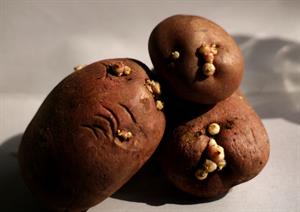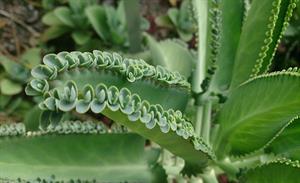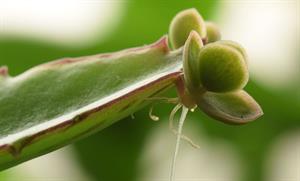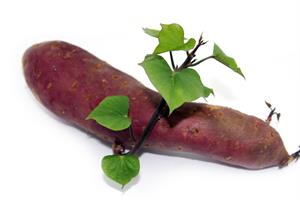
PUMPA - SMART LEARNING
எங்கள் ஆசிரியர்களுடன் 1-ஆன்-1 ஆலோசனை நேரத்தைப் பெறுங்கள். டாப்பர் ஆவதற்கு நாங்கள் பயிற்சி அளிப்போம்
Book Free DemoVegetative propagation through modified stem:
- Plants which have modified stems are called tuberous stem.
- It has nodes which bear buds which can form new plants.
- Each of the buds are called the eyes (appears like scar) in a potato which can grow into a new plant when it is planted in the soil.
- The tubers (stem or root) can store nutrients or food.
Example:
Other plants like ginger and turmeric also have buds on the stem tuber.

Other methods that involve vegetative propagation through stem are grafting, budding, and layering.


Vegetative propagation through leaves:
Bryophyllum (also called sprout leaf plant) has buds in the leaf margin. If the leaf is burried on a moist soil, the margins of the leaves develop into a new plant that resemble parent.


Vegetative propagation through roots:
- In plants like sweet potato, dahlia, etc., a new plant develops through tuberous roots (acts as a storage organ) and bulbs (onion).
- There are buds present on these modified storage roots that can grow above the ground and a new plant is formed.

Advantages of Vegetative propagation
- It takes less time to grow and also bears flowers and fruits earlier than those produced from seeds.
- New plants are exactly the copies of the parent plant.
Summary of vegetative propagation with examples:
Vegetative propagation | Example |
Stem cuttings | Sugarcane, rose, champa, grapes, jasmine, banana, cactus |
Modified stem | Potato, ginger, and turmeric |
Leaf | Bryophyllum |
Root cuttings | Sweet potato, dahlia, blackberry |
Reference:
https://pixabay.com/photos/potato-harvest-vegetable-garden-5025124/
https://commons.wikimedia.org/wiki/File:Bryophyllum_sp_2.jpg
https://commons.wikimedia.org/wiki/File:Bryophyllum_Daigremontianum_macro_1.jpg